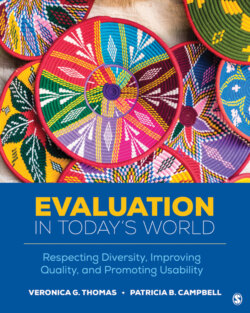Читать книгу Evaluation in Today’s World - Veronica G. Thomas - Страница 148
На сайте Литреса книга снята с продажи.
Methodological Approaches and Paradigm Wars
ОглавлениеEvaluation in the 1960s and 1970s was undoubtedly a quantitative enterprise. During the 1960s and 1970s, new developments in techniques and methodologies appeared that promised to raise the overall quality of evaluations. Perhaps the most impressive and substantial achievements during this time were those of large-scale field experiments. Each of the country’s major federal departments that operated social programs had at least one large-scale field experiment taking place during the 1970s, including, for example, (a) housing allowance experiments (U.S. Department of Housing and Urban Development); (b) experiments on transitional aid to release prisoners and on supported work (U.S. Department of Labor); and (c) enhanced police patrolling (U.S. Department of Justice) (cited in Rossi & Wright, 1984).
Leaders in the field at that time, such as Donald T. Campbell, Peter H. Rossi, and Carol H. Weiss, generally argued for evaluation to take advantage of the methods of research and analysis being utilized in the most prestigious domains (mostly quantitative methods) of social science such as psychology and sociology. As stated earlier in this chapter, Suchman (1967) published one of the earliest textbooks in evaluation, Evaluative Research: Principles and Practices in Public Service and Social Action Programs, which also placed emphasis on use of the experimental design (discussed in greater detail in Chapter 11).
In evaluation, like other social and behavioral science fields, during the 1970s and 1980s the dominant use of quantitative methods came under attack as part of the paradigm wars. There was increasing recognition that while experimental design may work in small-scale evaluation studies, it is more “difficult” or “unworkable” in the context of large-scale social and educational programs, resulting, in part, in findings showing program failure (Brandon & Sam, 2014). The 1978 meeting of the Evaluation Research Society devoted substantial program time to consideration of qualitative methods (Patton, 1980). With the initial publication of Qualitative Evaluation Methods, Michael Quinn Patton (1980) provided evaluators with a reference for expanding their methodological approaches to include qualitative methods. In his book, Patton argues that
the issue of selecting methods is no longer one of the dominant paradigm versus the alternative paradigm of experimental designs with quantitative measurement versus holistic-inductive design based on qualitative measurement. The debate and competition between paradigms [are] being replaced by a new paradigm—a paradigm of choices. The paradigm of choices recognizes that different methods are appropriate for different situations. (p. 20)
By the mid-1980s, the evaluation literature was beginning to reflect the potential value of integrating quantitative and qualitative methods for the purposes of both triangulation (L. Smith & Kliene, 1986) and enhancing the rigor and credibility of evaluations (Silverman, Ricci, & Gunter, 1990).
